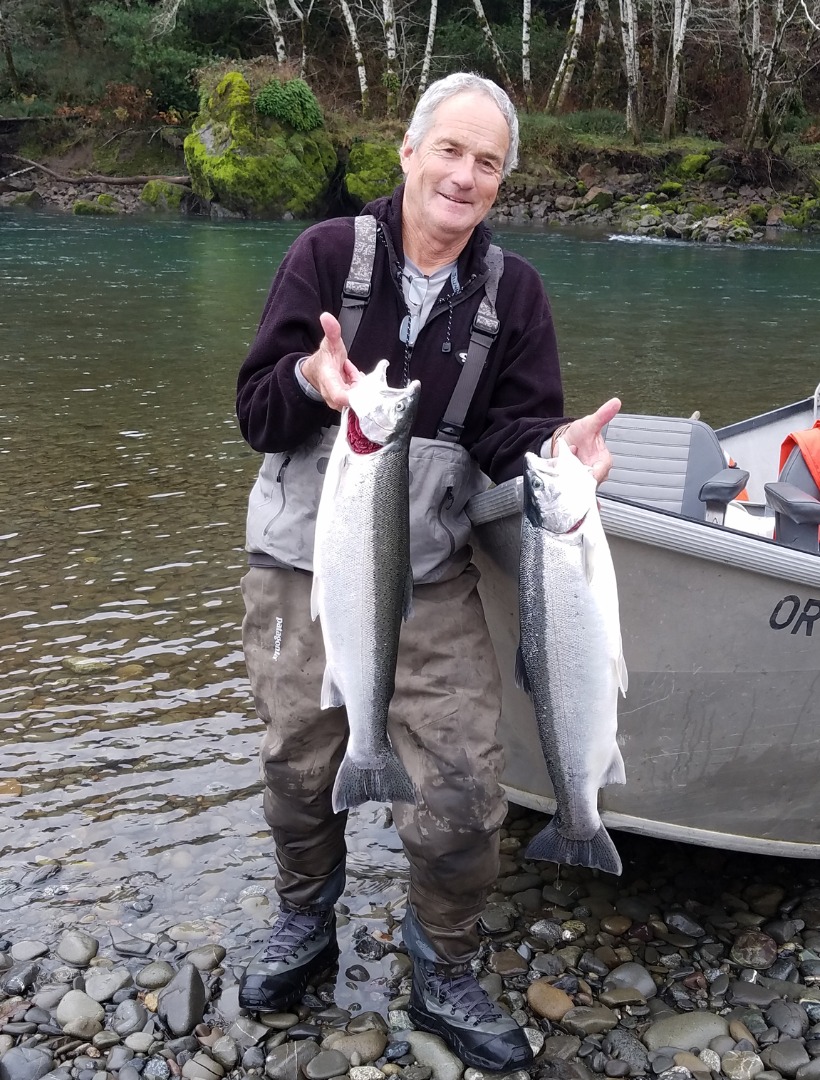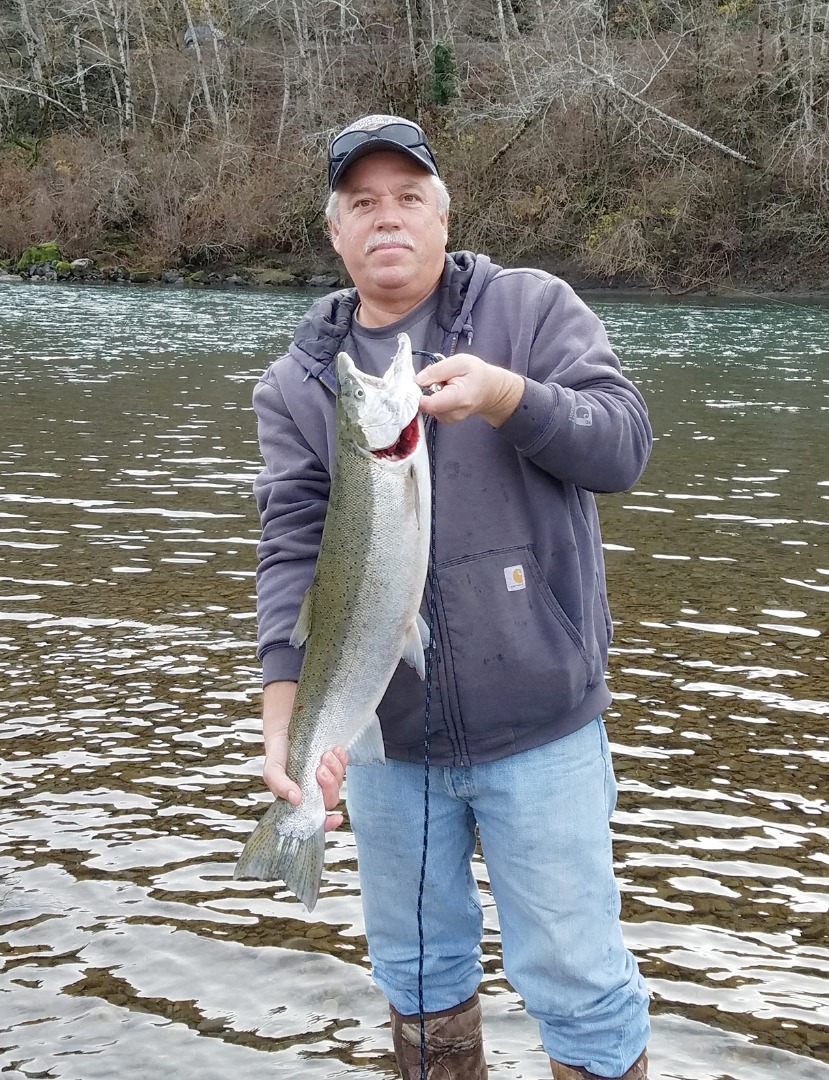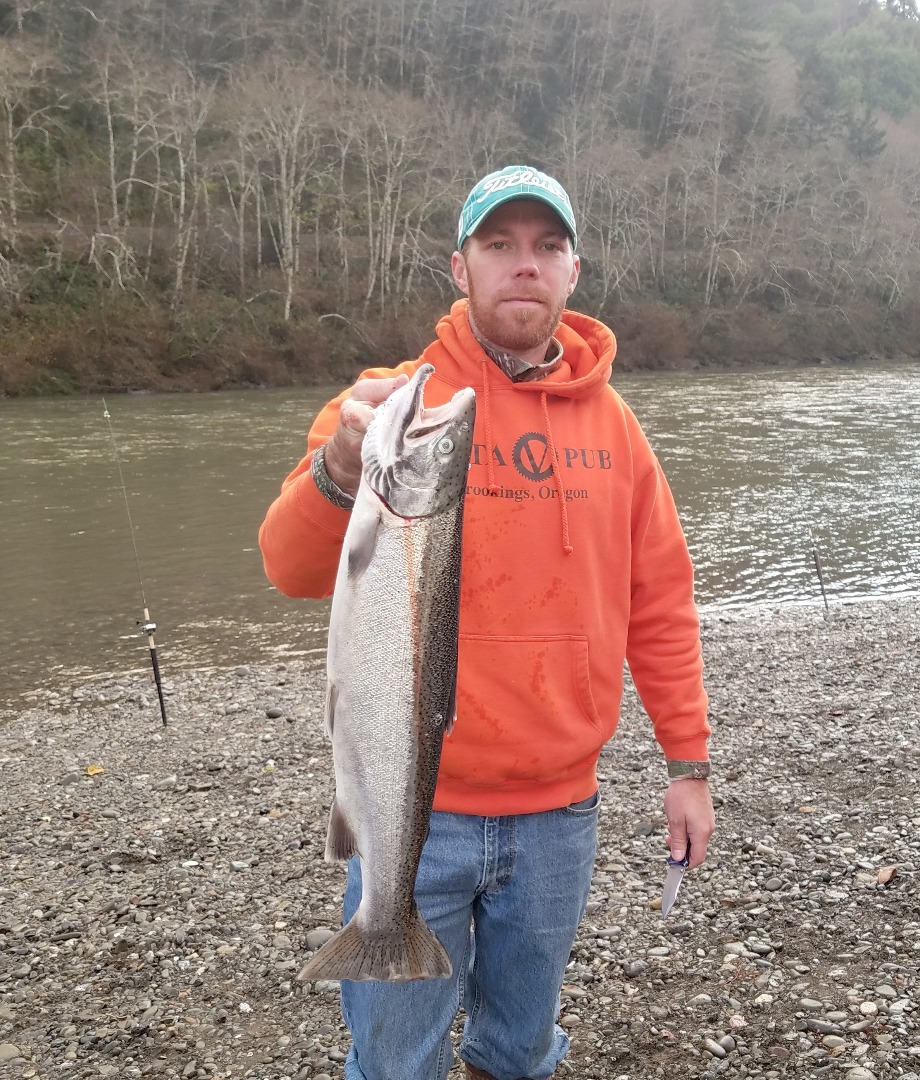Chetco River Fish Report for 1-6-2018
Lingcod Opener Totally Off the Hook
Chetco River - Brookings, OR (Curry County)

by Larry Ellis
1-6-2018
Website
Anglers who had their sights set on catching their first lingcod of 2018 on Monday's opener came back to the Port of Brookings Harbor cleaning tables humming the tune of buzzing electric fillet knives, and went home with plenty of meat to fill their stomachs and freezers.
The lingcod bite was said to be off the charts. They were everywhere - like the ubiquitous fog.
"I went out on the first day and the lingcod bite was just phenomenal," said Mike Van Camp from the Chetco Outdoor Store in Brookings. "We probably boated 30 lings and lost at least that many."
Van Camp said that shrimp flies were being ripped, nay - bitten completely off the mainline dropper loops by the prehistoric tooth-meisters.
"The females still had a lot of eggs in them and the males were still milking," said Van Camp. "I personally didn't keep any females at all."
An off-the-chart bite such as what happened on January 1 and 2 usually occurs during the heat of the spawning season during March, when 8 or more males will be caught in between the pinnacles while they are guarding a single female's roe nest.
But this red-hot, first-of-January bite saw equal-opportunity males and females being caught, which is uncharacteristic for spawning lingcod.
This white-hot lingcod bite also portends a greater season yet to come.
"None of the fish that I caught had spawned," said Andy Martin of Brookings Fishing Charters. "I caught quite a few females and they all had eggs in them, and all the males had milt sacks. That's a good sign because that means we're going to have lingcod fishing for a solid 2 to 3 months."
Martin, who fished both January 1 and 2, said that the lingcod fishing was so good, he described the bite as being "wide open".
"And we let a ton of fish go," he said. "The lingcod were just everywhere. We caught them off of Chetco Point; we caught them at Bird Island; we caught them at Twin Rocks and we caught them at House Rock. And when we went inside in the kelp to catch rockfish, we were catching lingcod in the kelp!"
Catching rockfish was another story.
Most anglers had to struggle for their Sebastes varieties of rockfish, but Martin limited out his passengers on both days.
Including a very large brown rockfish, Sebastes auriculatus to be specific.
Featured in one of today's photographs, an extremely-huge brown rockfish (aka: brown bomber) was caught by one of Martin's clients, Scott Hood of Chico, California.
The markings on this particular rockfish are striking, and once you've identified one such rockfish, the other brownies will follow suit.
Note, that like many rockfish, this one has 13 hard dorsal spines. Don't forget to count the short one toward the front of the fish, and the thirteenth spine that is connected to the tissue adjoining the first soft dorsal ray. Number 13 is often the one that will stick you by surprise because of its close proximity to the beginning of the soft dorsal rays.
One of the main identifying characteristics of a brownie is a round-ish brown-to-black-colored spot on the rear corner of each operculum, or gill cover. Sometimes brownies are mistaken for copper rockfish or even quillbacks, however if you remember the spot at the top-rear of the gill cover, you can never go wrong in identifying this creature.
They also will often have orange-ish stripes on its head, radiating backward from its jaw and eyes.
The current I.G.F.A. all-tackle world record is precisely 4 pounds. This particular brown rockfish looked to be an easy 4-pound-plus specimen. So if you're a trophy hunter looking to get your name in the record books, there's probably another one where it came from.
Chetco Still Kicking Out Steelhead With Water Expected to Rise
The Chetco River was still kicking out a few steelhead a day, even with low water, with fresh pods of between 3 and 7 fish entering the river at a time.
And I am on the river practically every day to testify to this fact, so there are undoubtedly many more than a few steelhead being caught a day.
Even so, I would rate the steelhead fishing as being fair at best.
Fishermen had to really work to get a fish last week, but several plunkers were able to coax a few willing biters to engulf their number 4 Spin-N-Glos, even at 1,000 cfs!
A few side-drifters and plug-pullers in drift boats were able to unhinge their rusty jaws as well, with guide Harvey Young of Fishawk River Company getting two hatchery metalheads for his two clients from Ashland, Oregon by side-drifting Puff Balls-and-roe.
The river was hovering between 1,000 and 1,100 cfs and was gin clear.
"We really had to work hard for these fish," said Young on Thursday. "But everything should pick up again after the river rises."
Should the river get low and clear after this weekend's rain, remember that "stealth" should always be your guide. Don't wear your favorite lily-white hat and flashy duds. When in doubt, look like a rock or a tree and go completely camo - no joke.
Also when the river is running clear, get your plugs as far back behind the boat as possible.
The National Weather Service is predicting that the Chetco might come up to 4,000 cfs this weekend. Although their forecasts have left a lot to be desired of late, it is looking like the Chetco is going to get doused with rain this time.
If that happens, be prepared to deploy all techniques ranging from side-drifting, plug pulling, drift-fishing and plunking.
But please, still leave your lily-white hat at home!
Tight lines!
Larry Ellis, author, writer, columnist and photographer has had a 50-year passion for fishing in California and Oregon's saltwater and freshwater venues. He is a well-known writer for Oregon, Washington and California Fishing and Hunting News, Northwest Sportsman, California Sportsman and Pacific Coast Sportfishing. He currently writes monthly for Salmon Trout Steelheader Magazine, and is the author of two books, "Plug Fishing for Salmon" and "Buoy 10, the World's Largest Salmon Run." Both books can be bought from Amato Publications (amatobooks.com), Amazon and eBay. Ellis particularly loves living in his hometown of Brookings, Oregon - The heart of salmon country and gateway to fishing paradise.
Photos
More Reports

1-1-2018
It's been an excruciating 105 days since Oregon bottom fishermen have been prohibited to fish for rockfish, cabezon and lingcod...... Read More

12-23-2017
I always tell anglers that the first rains around the Christmas holiday signals the first major runs of winter steelhead...... Read More

Website Hosting and Design provided by TECK.net
